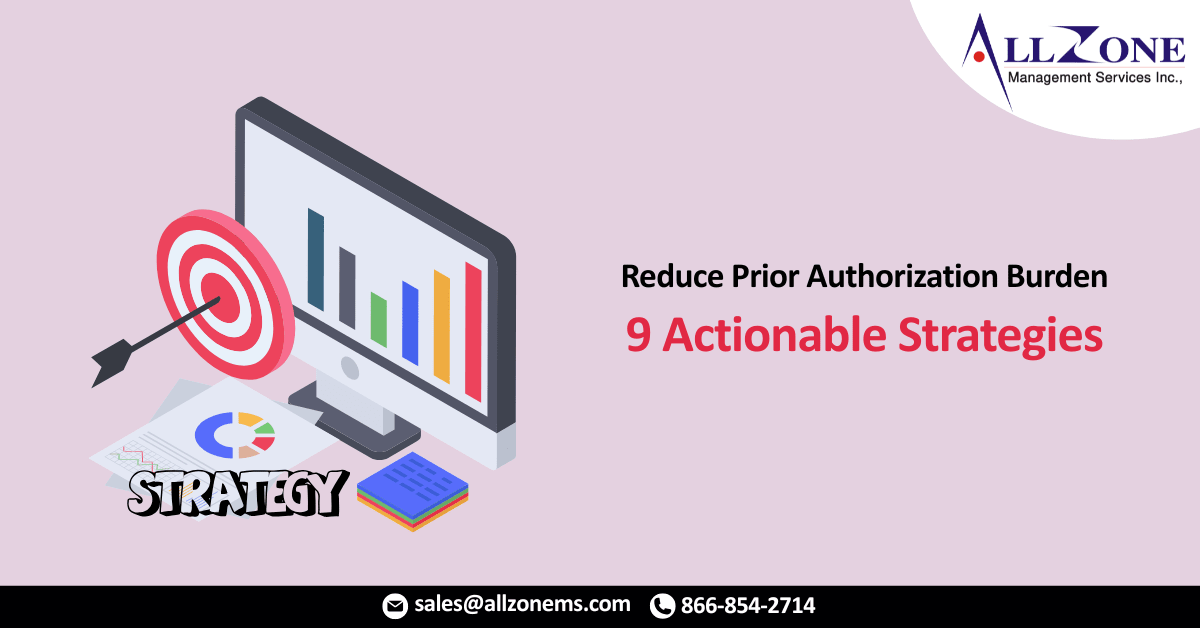Prior authorization (PA) is a necessary but often frustrating part of the healthcare reimbursement process, and the prior authorization burden it creates is substantial. While insurers use it to manage costs and ensure medical necessity, the administrative burden it places on physicians, billing staff, and patients is immense. A 2022 American Medical Association (AMA) survey found that 94% of physicians reported care delays due to prior authorization, and 80% said it sometimes leads patients to abandon treatment.
With mounting payer requirements and staffing challenges, practices need smart, actionable solutions. Here are nine proven ways to ease the prior authorization burden and streamline your operations.
1. Centralize and Standardize the Process:
One of the first steps in reducing the prior authorization burden is to centralize the process within your organization. Assign a dedicated team or point person who handles all PA submissions, follow-ups, and documentation. Standardize workflows, templates, and communication protocols so every payer and service has a clear path for authorization.
Pro Tip: Use checklists for common procedures and payer-specific requirements to avoid missing documents or steps.
2. Leverage Electronic Prior Authorization (ePA) Tools:
Manual prior authorization processes are time-consuming and error-prone. Electronic prior authorization (ePA) systems automate data exchange between providers and payers, reducing delays and administrative load.
Many EHR systems now include integrated ePA capabilities or support add-ons that interface directly with payer portals. According to CAQH, electronic prior authorizations reduce turnaround times by 69%.
Bonus: ePA also helps track status updates and approvals in real-time—no more endless phone calls and faxes.
3. Integrate PA Into Your EHR Workflows:
EHR integration is essential for reducing redundant data entry and improving workflow efficiency, directly addressing a significant aspect of the Prior Authorization Burden. Choose tools that embed PA forms directly into the clinical workflow, allowing physicians and staff to initiate authorizations during the patient visit or shortly after, thereby minimizing administrative overhead.
Example: When a physician orders a test, the system prompts any necessary PA documentation automatically, guiding the user through payer-specific steps.
4. Stay Updated with Payer Requirements:
Each payer has its own prior authorization rules, which change frequently. Staying on top of these changes is critical to prevent denials and rework. Maintain a living database of payer guidelines and assign someone to monitor updates from major insurers.
Tip: Subscribe to payer newsletters or join professional forums to stay informed on the latest changes in PA policies.
5. Educate Clinical and Front Office Staff:
Prior authorization isn’t just a billing issue—it begins with the clinical decision and patient scheduling. Educate all team members involved in the patient journey about:
- Which services typically require prior auth
- How to identify red flags in real time
- Best practices for documenting medical necessity
Training Tip: Hold regular refresher sessions and create quick-reference guides for new staff.
6. Use Data to Identify High-Volume PA Services:
Look at your internal data to identify trends—which procedures, medications, or tests most frequently require PA? Focus your process improvements and training efforts on these high-impact areas.
Example: If 60% of your radiology orders need prior auth, streamline the workflow for imaging referrals and preload documentation templates into your EHR.
This kind of targeted approach can yield outsized efficiency gains.
7. Track Metrics and Optimize Over Time:
You can’t improve what you don’t measure. Track metrics like:
- Number of PA requests submitted
- Approval/denial rates
- Average time to approval
- Resubmission or appeal frequency
Use this data to find bottlenecks and optimize the process. Even small tweaks—like changing the timing of submissions or adjusting templates—can significantly reduce delays.
8. Outsource When Necessary:
For practices overwhelmed by prior authorization workload, outsourcing to a medical billing or RCM company with PA expertise can be a game-changer. These teams specialize in navigating payer rules, speeding up approvals, and reducing denials.
Benefits of outsourcing include:
- Faster turnaround times
- Fewer staff hours spent on PA
- Increased revenue due to fewer delays and rejections
Just be sure to partner with a vendor who understands your specialty and has strong payer relationships.
9. Advocate for Policy Changes:
Long-term relief from PA burden will only come with systemic change. Encourage your providers and administrators to:
- Join professional societies (like AMA, MGMA, or AAFP) that lobby for PA reform
- Participate in surveys and case studies
- Support state or federal legislation that promotes automation and transparency in the PA process
Your voice can help push for a more rational, patient-centered approach to authorization requirements.
Easing the Burden, Empowering Your Practice:
The prior authorization burden doesn’t have to be an insurmountable obstacle. By implementing these nine strategies, you can take control of the process, streamline your workflows, and free up valuable time and resources. Companies like Allzone RCM Company understand the intricacies of revenue cycle management, including the prior authorization burden, and can be valuable partners in navigating these complexities.
Embracing technology, standardizing processes, and fostering collaboration are key to navigating the complexities of prior authorization and ultimately delivering better care to your patients. Start implementing these changes today and experience the positive impact on your practice and your team.

